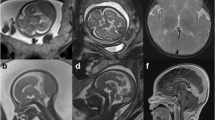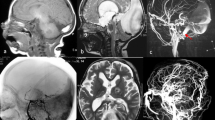Abstract
Dural sinus malformations (DSMs) are rare congenital vascular diseases characterized by a giant venous pouch with or without arteriovenous shunts. We present a neonatal case of DSM that was diagnosed prenatally and treated via endovascular intervention in the early postnatal period. The patient presented with a large DSM involving the torcular Herophilion prenatal magnetic resonance imaging (MRI). Enlargement of the head circumference and respiratory failure rapidly progressed after birth. On the 5th day after birth, the neonate underwent endovascular occlusion via the umbilical artery. The arteriovenous shunt was occluded, and the reflux from the enlarged venous pouch to the dural sinus was decreased. No additional procedure other than ventriculoperitoneal shunting was required. The neonate’s development slowly caught up to normal parameters. Follow-up MRI demonstrated the successful development of the venous drainage system. DSMs are characterized by an abnormally dilated dural sinus, which can block the venous return and ultimately increase intracranial pressure and cerebral ischemia. Long-term follow-up indicates that an abnormally developed dural sinus can be reconstructed by appropriate and timely treatment.




Similar content being viewed by others
Data availability
Data from this manuscript are available upon reasonable request.
Abbreviations
- AV shunts:
-
Arteriovenous shunts
- CSF:
-
Cerebrospinal fluid
- DSM:
-
Dural sinus malformation
- MRI:
-
Magnetic resonance imaging
- NBCA:
-
N-butyl-2-cyanoacrylate
- SD:
-
Standard deviation
- SOV:
-
Superior orbital vein
- SSS:
-
Superior sagittal sinus
References
Smajda S et al (2021) Endovascular management of torcular dural sinus malformations in children: the role of straight sinus occlusion. J Neurointerv Surg 13(3):278–283
Barbosa M et al (2003) Dural sinus malformations (DSM) with giant lakes, in neonates and infants. Review of 30 consecutive cases. Interv Neuroradiol 9(4):407–24
Smajda SJ et al (2022) Paediatric intracranial dural arteriovenous shunts: types, clinical presentation and therapeutic management. Brain Commun 4(2):fcac043
Hetts SW et al (2016) Pediatric intracranial dural arteriovenous fistulas: age-related differences in clinical features, angioarchitecture, and treatment outcomes. J Neurosurg Pediatr 18(5):602–610
Ku JC et al (2021) Improving long-term outcomes in pediatric torcular dural sinus malformations with embolization and anticoagulation: a retrospective review of The Hospital for Sick Children experience. J Neurosurg Pediatr 28(4):469–475
Yang E et al (2018) Imaging features and prognostic factors in fetal and postnatal torcular dural sinus malformations, part II: synthesis of the literature and patient management. J Neurointerv Surg 10(5):471–475
Okudera T et al (1994) Development of posterior fossa dural sinuses, emissary veins, and jugular bulb: morphological and radiologic study. AJNR Am J Neuroradiol 15(10):1871–1883
Ishiguro T et al (2008) Dural sinus malformation in a neonate: case report. JNET 2:222–227
Liby P et al (2020) Torcular dural sinus malformations: a single-center case series and a review of literature. Childs Nerv Syst 36(2):333–341
Acknowledgements
We thank Enago for the English review and editing.
Author information
Authors and Affiliations
Contributions
S.H. and A.M. wrote the main manuscript and figures. D.H. and T.M. contributed the treatment and advised the more appropriate information to write this manuscript. M.S., Y.M. and E.I. contributed the intervention treatment and advised the more appropriate information to write this manuscript. All authors reviewed the manuscript.
Corresponding author
Ethics declarations
Ethics approval
IRB approval for a case report is waived at the Tsukuba University Hospital.
Consent for publication
Written informed consent was obtained from the patient’s mother for publication of this case report and accompanying images.
Conflict of interest
The authors declare no competing interests.
Additional information
Publisher's Note
Springer Nature remains neutral with regard to jurisdictional claims in published maps and institutional affiliations.
Rights and permissions
Springer Nature or its licensor (e.g. a society or other partner) holds exclusive rights to this article under a publishing agreement with the author(s) or other rightsholder(s); author self-archiving of the accepted manuscript version of this article is solely governed by the terms of such publishing agreement and applicable law.
About this article
Cite this article
Hanai, S., Muroi, A., Hitaka, D. et al. Remodeling of venous drainage after the treatment of dural sinus malformation with arteriovenous shunts in a neonate: a case report and literature review. Childs Nerv Syst 39, 2245–2249 (2023). https://doi.org/10.1007/s00381-023-05961-w
Received:
Accepted:
Published:
Issue Date:
DOI: https://doi.org/10.1007/s00381-023-05961-w




